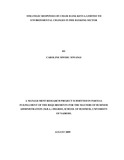| dc.description.abstract | The banking industry must continuously adapt its operations to the constantly changing
environment in order to succeed in business. Several changes have taken place in the world
economies particularly in the banking industry. In order to survive in this dynamic
environment, banks need strategies that are focused on their activities and deal with emerging
environmental and industry challenges accordingly.
Chase Bank Kenya Limited is a financial institution that is facing environments such as
global and dynamic. Within a span of two years, financial institutions with a heritage of one
hundred years have either ceased to exist or been acquired by more adapt players thanks to
the current global financial crisis. This crisis is bringing unprecedented change to the
financial services industry irrespective of organization size, focus or geography. This study is
set up to establish the responses being utilized by Chase bank in the face of increasing
environmental changes and industry forces. The first objective of the study was to determine
how Chase bank has responded to changes in the environment. These are: technological,
economic, political and social factors.
The second was to determine how Chase bank has responded to changes in the industry
forces. Theses are: threat of entry, threat of substitute product, bargaining power of buyers,
bargaining power of suppliers and competitive rivalry.
According to the study, the bank has been influenced by various factors which were
identified as being facilitators or challenges. The notable facilitators unique to the bank were;
strong customer relations with recognition, open, dynamic, youthful and energetic culture,
competitive foreign exchange pricing and branch network which is attractive to the High Net
Worth individual. The documented challenges are the cumbersome and complicated banking
system, low brand awareness in the market, increased competitive rivalry, entrance of new
more dynamic players into the local market and market volatility.
Chase bank has managed to be successful thus far in managing environmental challenges due
to the open-minded attitude of the management and thus strategic responses to these changes.
The future of the business will depend on how well the bank is able to adjust their business
operations to the volatile environment. The research suggests a study to find out how the firm
vi
formulates these strategies, specifically to determine factors which influence the choice of
strategies within the organization.
From the study, it is clear that Chase Bank recognizes the fact that it is working in a dynamic
environment. It also realizes that for it to sustain good performance, it has to continually
make changes so as to adapt to the environment. The firm sees the need to delight its
customers by satisfying their needs and exceeding their expectations. The firm has chosen to
adopt a proactive posture. | en |

